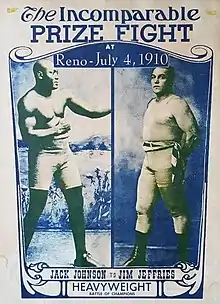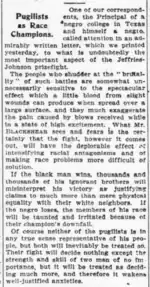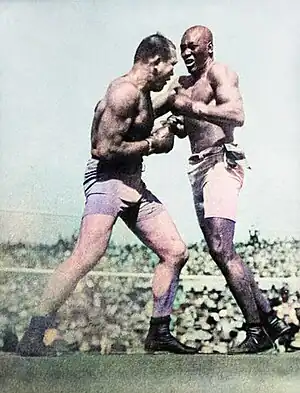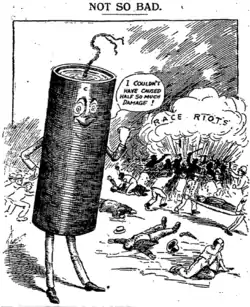Jack Johnson vs. James J. Jeffries
The Fight of the Century or the Johnson–Jeffries Prize Fight was a boxing match between the first African American World Heavyweight Champion of Boxing Jack Johnson and the previously undefeated World Heavyweight Champion James J. Jeffries on July 4, 1910, US Independence Day. It was highly significant in the history of race relations in the U.S., and led to the Johnson–Jeffries riots in which more than 20 people died.
 Promotional poster | |||||||||||||||||||
| Date | July 4, 1910 | ||||||||||||||||||
|---|---|---|---|---|---|---|---|---|---|---|---|---|---|---|---|---|---|---|---|
| Venue | Reno, Nevada, United States | ||||||||||||||||||
| Tale of the tape | |||||||||||||||||||
| |||||||||||||||||||
| Result | |||||||||||||||||||
| Johnson won via 15th round TKO | |||||||||||||||||||
It was one of the most eagerly anticipated boxing matches of all time, with betting odds significantly favoring Jeffries,[2] who had come back from retirement for the fight. The lead-up to the bout was peppered with racist press against Johnson; author Jack London described Jeffries two days before the fight as "the chosen representative of the white race, and this time the greatest of them", whilst a New York Times editorial wrote: "If the black man wins, thousands and thousands of his ignorant brothers will misinterpret his victory as justifying claims to much more than mere physical equality with their white neighbors."[3][4]
Johnson beat Jeffries in the fifteenth round, approximately one hour after the fight began at 1:30 pm PST. Jeffries—who boasted that he had never been knocked down in a fight—fell three times to Johnson's punches, and was being counted out when his manager called the fight.[5][6] Race riots broke out across the country over the following week—the first truly nationwide race riots in the United States.[7][8][9]
A crowd of 18,020 attended in a stadium built for the fight, and telegraphed reports were followed across the nation. Johnson and Jeffries both made over $100,000 from the purse, bonuses, and the sale of film rights. The film – The Johnson–Jeffries Fight – received more public attention in the United States than any other film to date and for the next five years, until the release of The Birth of a Nation,[10] and was subsequently censored in many states and cities – the first movement for racist film censorship in history.[11]
Background

In 1910, former undefeated heavyweight champion James J. Jeffries, came out of retirement to challenge Johnson, saying "I am going into this fight for the sole purpose of proving that a white man is better than a Negro".[12] Aged 35, he had not fought in six years and he had to lose well over 100 pounds (45 kg) in order to get back to his championship fighting weight. Efforts to persuade Jeffries to "retrieve the honor of the white race" began immediately after the Tommy Burns–Johnson fight.[13] Initially Jeffries had no interest in the fight, being quite happy as an alfalfa farmer.[14] However, on October 29, 1909, Johnson and Jeffries signed an agreement to "box for the heavyweight championship of the world" and called promoters to bid for the right to orchestrate the event.[13]
In early December 1909, Johnson and Jeffries selected a bid from the nation's top boxing promoters—Tex Rickard and John Gleason. The bid guaranteed a purse of $101,000 to be divided 75% to the winner and 25% to the loser, as well as two-thirds of the revenues collected from the sales of the right to film the fight (each boxer received one third of the equity rights).[13] Although it was well understood that a victory for Jeffries was likely to be more profitable than a victory for Johnson, there were no doubts that the event would produce record profits.[13] Legal historian Barak Orbach argues that in "an industry that promoted events through the dramatization of rivalries, a championship contest between an iconic representative of the white race and the most notorious [black fighter] was a gold mine."[13] Jeffries mostly remained hidden from media attention until the day of the fight, while Johnson soaked up the spotlight. John L. Sullivan, who made boxing championships a popular and esteemed spectacle, stated that Johnson was in such good physical shape compared to Jeffries that he would only lose if he had a lack of skill on the day of the fight. Before the fight, Jeffries remarked, "It is my intention to go right after my opponent and knock him out as soon as possible." His wife added, "I'm not interested in prizefighting but I am interested in my husband's welfare, I do hope this will be his last fight." Johnson's words were "May the best man win."[15]
Racial tension was brewing in the lead-up to the fight and in order to prevent any harm from coming to either boxer, guns were prohibited within the arena along with the sale of alcohol and anyone who was under the effects of alcohol. Apples were also banned as well as any weapon whatsoever. Behind the racial attitudes which were being instigated by the media was a major investment in gambling for the fight, with 10–7 odds in favor of Jeffries.[16] The lead-up to the bout was peppered with racist press against Johnson; American author Jack London described Jeffries two days before the fight as "the chosen representative of the white race, and this time the greatest of them", whilst a New York Times editorial wrote: "If the black man wins, thousands and thousands of his ignorant brothers will misinterpret his victory as justifying claims to much more than mere physical equality with their white neighbors."[3][4]
The fight

The fight took place on July 4, 1910, in front of nearly 20,000 people, at a ring which was built just for the occasion in downtown Reno, Nevada. Jeffries proved unable to impose his will on the younger champion and Johnson dominated the fight. By the 15th round, after Jeffries had been knocked down twice for the first time in his career, Jeffries's corner threw in the towel to end the fight and prevent Jeffries from having a knockout on his record.[17]
Johnson later remarked he knew the fight was over in the 4th round when he landed an uppercut and saw the look on Jeffries's face, stating, "I knew what that look meant. The old ship was sinking."
The "Fight of the Century" earned Johnson $65,000 (over $2 million in 2022 dollars) and silenced the critics, who had belittled Johnson's previous victory over Tommy Burns as "empty", claiming that Burns was a false champion since Jeffries had retired undefeated. John L. Sullivan commented after the fight that Johnson won deservedly, fairly, and convincingly:
The fight of the century is over and a black man is the undisputed champion of the world. It was a poor fight as fights go, this less than 15-round affair between James J. Jeffries and Jack Johnson. Scarcely has there ever been a championship contest that was so one-sided. All of Jeffries much-vaunted condition amounted to nothing. He wasn't in it from the first bell tap to the last ... The negro had few friends, but there was little demonstration against him. (Spectators) could not help but admire Johnson because he is the type of prizefighter that is admired by sportsmen. He played fairly at all times and fought fairly ... What a crafty, powerful, cunning left hand (Johnson) has. He is one of the craftiest, cunningest boxers that ever stepped into the ring ... They both fought closely all during the 15 rounds. It was just the sort of fight that Jeffries wanted. There was no running or ducking like Corbett did with me in New Orleans (1892). Jeffries did not miss so many blows, because he hardly started any. Johnson was on top of him all the time ... (Johnson) didn't get gay (confident) at all with Jeffries in the beginning, and it was always the white man who clinched, but Johnson was very careful, and he backed away and took no chances, and was good-natured with it all ... The best man won, and I was one of the first to congratulate him, and also one of the first to extend my heartfelt sympathy to the beaten man.[18]
Riots and aftermath

The outcome of the fight triggered race riots that evening—the Fourth of July—all across the United States, from Texas and Colorado to New York and Washington, D.C., Johnson's victory over Jeffries had dashed white dreams of finding a "great white hope" to defeat him. Many whites felt humiliated by the defeat of Jeffries.[19]
Blacks, on the other hand, were jubilant, and celebrated Johnson's great victory as a victory for racial advancement. Black poet William Waring Cuney later highlighted the black reaction to the fight in his poem "My Lord, What a Morning".[20]
Race riots erupted in New York, Baltimore, Pittsburgh, Philadelphia, New Orleans, Atlanta, St. Louis, Little Rock and Houston. In all, riots occurred in more than 25 states and 50 cities. At least 20 people were killed across the US from the riots,[21] and hundreds more were injured.[22][23][24][25][26][27][28][29][30]
Film of the bout
| Jeffries-Johnson World's Championship Boxing Contest | |
|---|---|
| Based on | Jack Johnson vs. James J. Jeffries |
| Produced by | John Stuart Blackton[31] |
| Starring | Jack Johnson James J. Jeffries |
| Distributed by | J. & J. Co. |
Release date |
|
Running time | 100 minutes |
| Country | United States |
| Language | Silent film |
Anticipation for the fight sparked motivation to film the event as it was thought to be a guaranteed money-maker. The fight's promoter, George "Tex" Rickard, (who also refereed the bout) sold exclusive film rights. The film was recorded by nine cameramen and is two hours long.[32] Jeffries-Johnson World's Championship Boxing Contest film, released the year of the fight, received more public attention in the United States than any other film to date and for the next five years, until the 1915 release of The Birth of a Nation.[10] In the United States, many states and cities banned the exhibition of the film. The movement to censor Johnson's victory took over the country within three days after the fight.[33]
Two weeks after the match former President Theodore Roosevelt, an avid boxer and fan, wrote an article for The Outlook in which he supported banning not just moving pictures of boxing matches, but a complete ban on all prize fights in the US. He cited the "crookedness" and gambling that surrounded such contests and that moving pictures have "introduced a new method of money getting and of demoralization".[33] The controversy surrounding the film directly[10] motivated Congress to ban distribution of all prize-fight films across state lines in 1912; the ban was lifted in 1940.[33]
In 2005, the film of the Jeffries–Johnson "Fight of the Century" was entered into the United States National Film Registry as being worthy of preservation.[34]
Legacy in media
- The Great White Hope (1967 play)
- The Great White Hope (1970 film)
References
- "Jack Johnson". BoxRec.com. Retrieved October 27, 2021.
- Orbach 2010, p. 273: Orbach cites: Betting is Peculiar, WASH. POST, July 4, 1910, at 2; 10 to 6 on Eve of Fight, N.Y. TIMES, July 4, 1910, at 14; Jeff Rules Favorite, 100–60, CHI. DAILY TRIB., July 4, 1910, at 11; Bet $40,000 on Jeffries, WASH. POST, July 4, 1910, at 2; Wall Street Slow to Place Bets on the Fight at Reno, N.Y. HERALD, July 2, 1910, at 2; How Betting Goes All Over the Country, PHILA. INQUIRER July 3, 1910, at 8; Betting Favors Jeffries; Odds of 10 to 6 1–2 Offered, ATLANTA CONST., July 4, 1910, at 9.
- "Pugilists as Race Champions". The New York Times. Vol. LIX, no. 19101. May 12, 1910. p. 10. Retrieved October 17, 2022.
- "A Year of Hope for Joplin and Johnson". Smithsonian Magazine. May 31, 2010. Retrieved August 14, 2022.
- "Johnson Wins In 15 Rounds; Jeffries Weak", The New York Times, July 5, 1910, p1
- Ed Cray, et al., American Datelines: Major News Stories from Colonial Times to the Present (University of Illinois Press, 2003), p129
- "80 Years Ago, the Truth Hurt : Johnson's Victory Over Jeffries Taught Lesson to White America". Los Angeles Times. July 8, 1990. Retrieved August 14, 2022.
Johnson's victory over Jeffries provided a lesson much of white America didn't learn gracefully. Johnson-Jeffries touched off America's first national race riot—several days of hundreds of violent street clashes between whites and blacks in cities across the country.
- Brundage, W.F. (2011). Beyond Blackface: African Americans and the Creation of American Popular Culture, 1890–1930. H. Eugene and Lillian Youngs Lehman series. University of North Carolina Press. p. 165. ISBN 978-0-8078-3462-6. Retrieved August 14, 2022.
In response, white observers set off arguably the first— ever nationwide race riots in US. history to repress...
- Allen, A.; Mace, J.W. (2017). Jess Willard: Heavyweight Champion of the World (1915–1919). McFarland, Incorporated, Publishers. p. 10. ISBN 978-1-4766-2637-6. Retrieved August 14, 2022.
The Reno fight triggered the first nationwide race riots in American history
- Abel, Richard (August 1, 2004). Encyclopedia of Early Cinema. ISBN 9780415234405.
- Orbach 2010, p. 273-274: "In the United States, racist movie censorship started with a movement that took over the country within three days after Jack Johnson knocked out the great white hope on the Fourth of July 1910... The final note must be dedicated to Jack Johnson, the target of the legal wildfire that banned fight films in many towns in the United States in the summer of 1910. On the Fourth of July 1910, Johnson knocked out a man who claimed to be stronger than him and for that he and many other blacks were prosecuted, and a dark wave of movie censorship emerged.
- Remnick, David "Struggle for his soul", The Observer, November 2, 2003. Retrieved on November 2, 2003
- Orbach 2010
- "The Jeffries Barn". wesclark.com. Retrieved March 13, 2022.
- Krasner, D. (2016). A Beautiful Pageant: African American Theatre, Drama and Performance in the Harlem Renaissance. Palgrave Macmillan US. p. 33. ISBN 978-1-137-06625-1. Retrieved August 14, 2022.
- Orbach 2010, p. 273a.
- "Jack Johnson Biography". Retrieved November 8, 2013.
- John L. Sullivan, cited in: Christopher James Shelton, Historian for The Boxing Amusement Park, "'Fight of the Century' Johnson vs. Jeffries, the 100th anniversary"
- Ken Burns (April 28, 2021). Unforgivable Blackness: The Rise and Fall of Jack Johnson. PBS. Retrieved August 14, 2022.
- Pool, Rosey E. (1962). Beyond the blues: new poems by American Negroes. Hand and Flower Press. p. 81.
- "Contributors: Jack Johnson (American boxer)". Encyclopædia Britannica. Retrieved November 27, 2014.
- "Los Angeles herald [microform]. (Los Angeles [Calif.]) 1900–1911, 5 July 1910, Image 1". Chronicilingamerica.loc.gov. July 5, 1910. Retrieved November 27, 2014.
- "Daily press. (Newport News, Va.) 1896–current, July 05, 1910, Image 1". Chronicilingamerica.loc.gov. July 5, 1910. Retrieved November 27, 2014.
- "The Meriden Daily Journal – Google News Archive Search". Chronicilingamerica.loc.gov. Retrieved November 27, 2014.
- "New-York tribune. (New York [N.Y.]) 1866–1924, July 06, 1910, Page 4, Image 4". Chronicilingamerica.loc.gov. July 6, 1910. p. 4. Retrieved November 27, 2014.
- "Deaths Result From Race Riots". The Washington Herald. July 6, 1910. p. 3. Chronicling America, United States Library of Congress.
- "Fight News is Followed by Race Riots in Many Parts of Country". Los Angeles Herald. July 5, 1910. p. 1. Chronicling America, United States Library of Congress.
- "Whites and Blacks Riot". New York Tribune July 5, 1910, p. 2. Chronicling America, United States Library of Congress.
- "Deputy Sheriff Wesley G. Davis". The Officer Down Memorial Page (ODMP). Retrieved October 27, 2021.
- "Note Officer Davis was the law officer killed Mounds Illinois 4 July 1910". Retrieved August 12, 2016.
- "Jeffries–Johnson World's Championship Boxing Contest, Held at Reno, Nevada, July 4, 1910 (1910) : Full Cast & Crew". IMDb.com. Retrieved January 9, 2016.
- Niemi, Robert (2006). History in the Media. p. 192. ISBN 9781576079522. Retrieved January 9, 2016.
- Orbach 2010.
- "National Film Registry 2005: Films Selected to the National Film Registry (National Film Preservation Board, Library of Congress)". Loc.gov. Archived from the original on February 8, 2014. Retrieved November 27, 2014.
Bibliography
- Hietala, T. R. (2002). The Fight of the Century: Jack Johnson, Joe Louis, and the Struggle for Racial Equality. M.E. Sharpe. ISBN 978-0-7656-0723-2. Retrieved August 14, 2022.
- Greenwood, R. (2004). The Prize Fight of the Century: Jack Johnson Vs. James Jeffries: Reno, Nevada, July 4, 1910. Jack Bacon & Company. ISBN 978-0-930083-13-7. Retrieved August 14, 2022.
- Orbach, B. Y. (2010). The Johnson-Jeffries Fight and Censorship of Black Supremacy (PDF). New York University Journal of Law & Liberty. Retrieved August 14, 2022.
- Rozen, W. A. (2004). America on the Ropes: A Pictorial History of the Johnson – Jeffries Fight. Casey Press LLC. ISBN 978-0-9762964-0-9. Retrieved August 14, 2022.
- Jack Johnson vs. James Jeffries: Topics in Chronicling America, Library of Congress